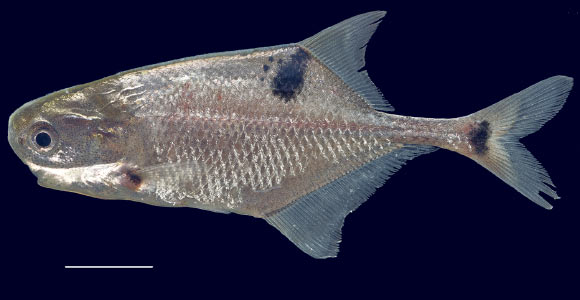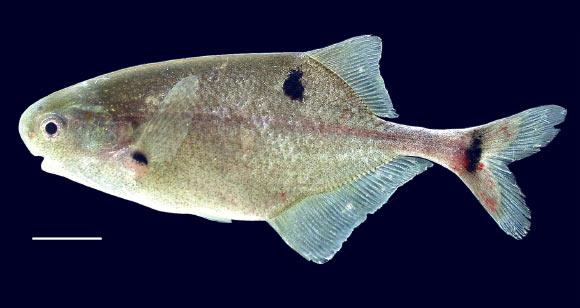Petrocephalus boboto and Petrocephalus arnegardi, two new species of weakly electric fish, have been described from the Congo River.

Petrocephalus boboto from Yangambi, Congo River, Democratic Republic of Congo. Scale bar – 1 cm. Image credit: Lavoué S, Sullivan JP.
Petrocephalus are African weakly fishes of the family Mormyridae that produce pulses of only a few hundred millivolts from an organ made of modified muscle cells in front of their tail.
Receptor cells on the fishes’ skin detect distortions to the electric field created by nearby objects in the water. In this way, they are able to electrolocate through their complex aquatic environment at night. Their short electric pulses, too weak to be sensed by touch, are also used to communicate the sender’s species identity and gender to other electric fishes.
On a 2010 field trip to the Congo River of Democratic Republic of the Congo, ichthyologists Dr Sébastien Lavoué from the Taiwan Institute of Oceanography and Dr John Sullivan from Cornell University captured a single individual of the genus Petrocephalus not quite like any they had seen before.

Petrocephalus arnegardi from Odzala-Kokua National Park, Congo River, Republic of the Congo. Scale bar – 1 cm. Image credit: Lavoué S, Sullivan JP.
As they had for hundreds of other Petrocephalus specimens collected in Central Africa since the late 1990s, they placed the small, silvery fish in a small basin with water from the river and recorded its electric organ discharge (EOD) with an oscilloscope, humanely euthanized it, took its photo, procured a tissue sample for DNA analysis, tagged it and preserved it in formaldehyde.
Back in their laboratory, the scientists sequenced the gene cytochrome b from the specimen. Comparing this sequence to those from other Petrocephalus specimens and careful examination of the fish’s morphology and its EOD helped him determine that it belonged to an undescribed species.
They named this species Petrocephalus boboto – the word ‘boboto’ means peace and fellowship in the Lingala language spoken along the Congo River.
“We named this hard-to-find Petrocephalus species ‘boboto’ in the hopes that solutions for peace – though elusive like this fish – can be found in eastern D.R. Congo and the other troubled areas of Central Africa,” said Dr Sullivan, who is the senior author of the paper appearing in the journal ZooKeys.
The ichthyologists discovered the other new Petrocephalus species in the Congo River basin.
They named it Petrocephalus arnegardi for Dr Matthew Arnegard, a scientist with the Fred Hutchinson Cancer Research Center in Seattle, Washington.
______
Lavoué S, Sullivan JP. 2014. Petrocephalus boboto and Petrocephalus arnegardi, two new species of African electric fish (Osteoglossomorpha, Mormyridae) from the Congo River basin. ZooKeys 400: 43–65; doi: 10.3897/zookeys.400.6743







